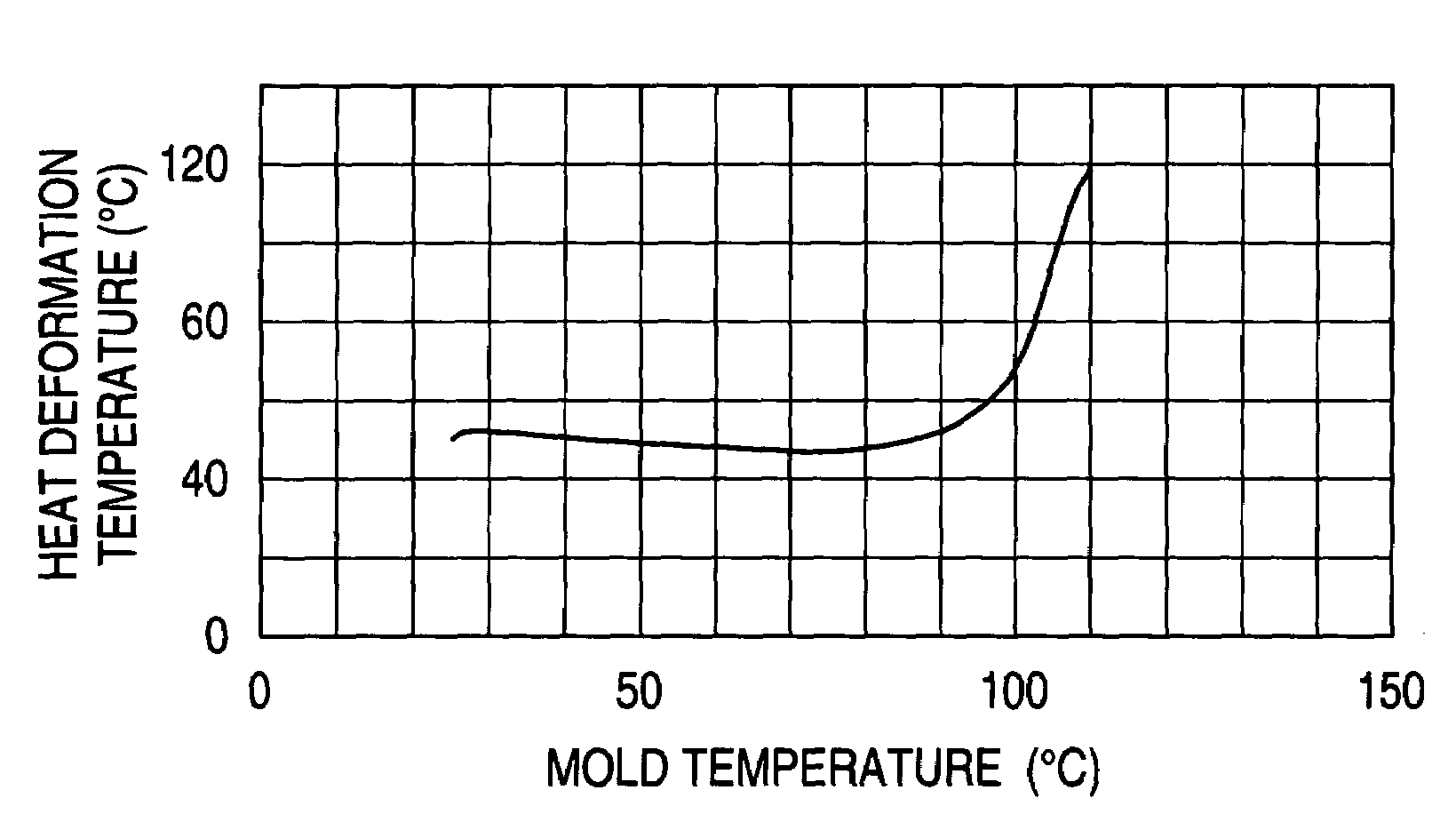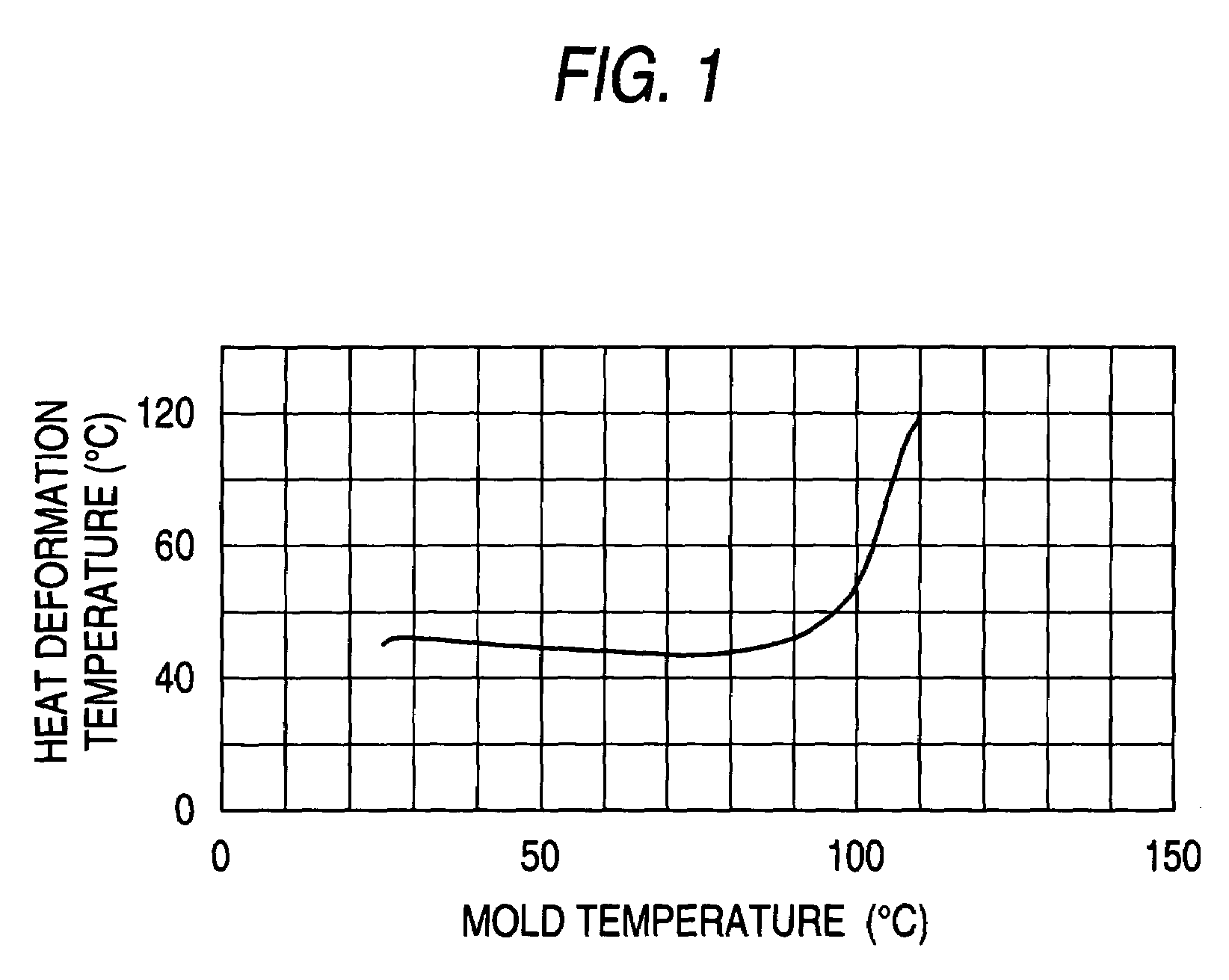Biodegradable resin composition and biodegradable resin molded article
- Summary
- Abstract
- Description
- Claims
- Application Information
AI Technical Summary
Benefits of technology
Problems solved by technology
Method used
Image
Examples
example 1
Preparation of a Copolymer Resin Obtainable by Copolymerizing at Least L-lactic Acid, a Polyhydric Alcohol and a Polybasic Carboxylic Acid (Resin (1))
[0056]Into a 90 L-volume inverted conical ribbon-impeller reactor equipped with a refluxing column were charged 25 kg of 90% L-lactic acid, 7.8 kg of polypropylene glycol (Mw=2,000), 0.5 kg of citric acid, and 15 g of monobutyltin oxide as a catalyst, and they were reacted at a reaction temperature of 190° C. under a gradually increasing vacuum of 9 kPa (70 Torr) to 0.01 kPa (0.1 Torr) at an impeller rotation number of 130 rpm for 22 hours. The weight-average molecular weight of the resulting resin (1) was found to be about 2,000,000 and the melting point (mp) was 121° C.
Preparation of a Copolymer Resin Obtainable by Copolymerizing at Least D-lactic Acid, a Polyhydric Alcohol and a Polybasic Carboxylic Acid (Resin (2))
[0057]Into a 500 mL-volume separable flask equipped with an air-cooler of 450 mm and an external stirring apparatus wer...
example 2
Preparation of a Copolymer Resin Obtainable by Copolymerizing at Least L-lactic Acid and a Saccharide (Resin (1))
[0060]Into a 90 L-volume inverted conical ribbon-impeller reactor equipped with a refluxing column were charged 30 kg of 90% L-lactic acid, 30 g of corn starch, and 15 g of monobutyltin oxide as a catalyst, and they were reacted at a reaction temperature of 190° C. under a gradually increasing vacuum of 9 kPa (70 Torr) to 0.01 kPa (0.1 Torr) at an impeller rotation number of 130 rpm for 22 hours. The weight-average molecular weight, melting point (mp), and glass transition temperature of the resulting resin (1) were found to be 480,000, 155° C., and 51° C., respectively.
Preparation of a Copolymer Resin Obtainable by Copolymerizing at Least D-lactic Acid and a Saccharide (Resin (2))
[0061]Into a 500 mL-volume separable flask equipped with an air-cooler of 450 mm and an external stirring apparatus were charged 200 g of D-lactic acid, 0.2 g of corn starch, 4 g of citric acid,...
example 3
[0064]The resins (1) and (2) obtained with blending composition and under reaction conditions shown in the following Table 1 were dry blended in blending ratios (part by weight) shown in the following Table 2 and then were mixed in a KRC kneader (a twin-screw kneader) manufactured by Kurimoto K.K. to obtain resin compositions.
[0065]
TABLE 1ItemResin (1)Resin (2)(Blendingcomposition)L-Lactic acid (mfd.30 kg—by Purac)D-Lactic acid (mfd.—30 kgby Purac)Starch (corn starch)30 g30 gMonobutyltin oxide15 g15 g(Reaction140° C. × 3 h, 70 Torr140° C. × 3 h, 70 Torrconditions)195° C. × 3 h, 70 Torr195° C. × 3 h, 70 Torr195° C. × 3 h, 4 Torr195° C. × 3 h, 4 Torr195° C. × 15 h, 0.1 Torr195° C. × 13 h, 0.1 Torr(24 hours in total)(22 hours in total)Mw (weight-average230,000210,000molecular weight)
[0066]
TABLE 2No.123456789Resin (1)10080706050403020—Resin (2)—20304050607080100Melting point (° C.)*1152200201205215214209209147Crystallization—100.2———————temperature ofcrystallized sample(° C.)*2Melting p...
PUM
| Property | Measurement | Unit |
|---|---|---|
| Temperature | aaaaa | aaaaa |
| Percent by mass | aaaaa | aaaaa |
| Percent by mass | aaaaa | aaaaa |
Abstract
Description
Claims
Application Information
 Login to View More
Login to View More - R&D
- Intellectual Property
- Life Sciences
- Materials
- Tech Scout
- Unparalleled Data Quality
- Higher Quality Content
- 60% Fewer Hallucinations
Browse by: Latest US Patents, China's latest patents, Technical Efficacy Thesaurus, Application Domain, Technology Topic, Popular Technical Reports.
© 2025 PatSnap. All rights reserved.Legal|Privacy policy|Modern Slavery Act Transparency Statement|Sitemap|About US| Contact US: help@patsnap.com


